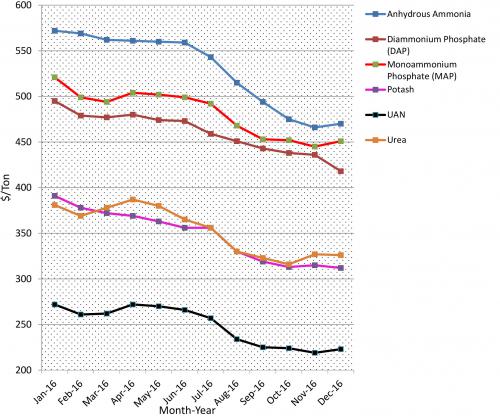Year-end fertilizer prices in 2016
The 2016 year-end retail prices of all major fertilizers were substantially lower compared to prices in the two previous years, according to USDA statistics.
The approximate retail prices for bulk purchases of major nitrogen (N)-phosphorus (P)-potassium (K) fertilizers per ton, published in the December 2016 USDA Illinois Department of Agriculture Market News Report, compared to corresponding prices in 2015 and 2014 are shown in the table below. The 2016 prices of all common fertilizers were substantially lower than the two previous years.
|
Retail prices for bulk purchases of major fertilizers in dollars per ton in December 2016 compared to 2015 and 2014. |
|||
|---|---|---|---|
|
Fertilizer source |
Dec. 2016 |
Dec. 2015 |
Dec. 2014 |
|
Diammonium phosphate (DAP) |
418 |
536 |
555 |
|
Monoammonium phosphate (MAP) |
451 |
553 |
583 |
|
Potash |
312 |
414 |
477 |
|
Urea |
327 |
393 |
455 |
|
Urea-Ammonium Nitrate (UAN 28%) |
223 |
293 |
335 |
|
Anhydrous ammonia |
470 |
650 |
728 |
The monthly price trends during 2016 are shown in the figure below. Generally, all fertilizer prices showed a declining trend throughout the year. The prevailing low grain prices are slowing the fertilizer demand. The fertilizer market may be sluggish in the foreseeable future. There is also an oversupply situation for all major fertilizers and it will take some time for the global market to balance out the supply and demand.

Fertilizer prices from January to December 2016. Data source: USDA-Illinois Dept. of Ag Market News Springfield, Ill., cash prices for bulk purchases, granular form unless noted.
Michigan State University Extension recommends producers be aware of price fluctuations over time and take advantage of purchasing options. When commodity prices are low, farmers can stay profitable by becoming more efficient at getting the best yield possible so they have more bushels to sell at harvest time. The favorable fertilizer prices should be an incentive for farmers not to cut back on fertilizer, but to provide all the crop nutrients as needed to achieve their full yield potential.



 Print
Print Email
Email